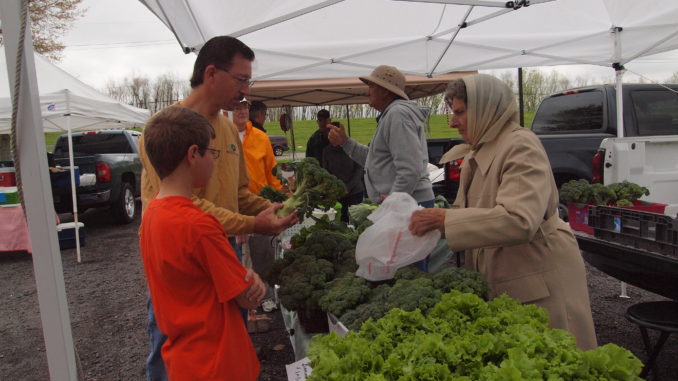
But $30,000 handout in jeopardy due to economy
During a St. Charles Parish Council meeting last week, a Hahnville resident and a few council members questioned whether the German Coast Farmers’ Market should continue to receive $30,000 in annual funding from the government.
Last year, more than 35,000 people visited the St. Charles market from all over southeast Louisiana. The market currently operates in two locations, Luling and Destrehan, each week.
“It would be wise to preserve its future by requiring it to become self-sufficient,” Hahnville resident Milton Allemand told the council at the Feb. 27 meeting. “This is no reflection on the operators at the market, the vendors that use it or the people that go there…I just think that after all these years we need to figure out a way to make this self-sufficient.”
Representatives from the award-winning market say that a decrease in parish funding would be detrimental.
“People look at the market as not only a place where you buy your fruits and vegetables and meats and go home, but they also look at it as a place where we rendezvous with people…we believe this strengthens community ties,” said Jara Roux, market treasurer and board member. “(If we lost parish funding) we would probably have to charge our farmers a fee that they would probably not be able to afford.”
Ann Montgomery, vice president of the market, said that she believes raising vendor fees would make it impossible for some farmers to sell at the market.
“It would be an extreme hardship for them to the point where I think some of them would just not come,” Montgomery said. “We don’t want to lose our subsidy.”
Volunteered time, grant money and vendor fees make up for what the market cannot afford with parish money.
Currently, regular vendors pay $45 annually and $15 per day that they sell.
“It’s not an unreasonable price but if it went up higher than that, it might be a little bit of a hardship,” said Mary Brinkman, a market vendor. Brinkman has been selling her Mama Mary’s Kitchen pepper jellies at the market for three years. She said she would not be able to come every Saturday if the prices went up.
While a 2000 survey by the USDA states that 82 percent of farmers’ markets nationally are self-sustaining, St. Charles is not the only parish government in Louisiana to support such a venture.
Paige Braud, communications director for St. John the Baptist Parish, said that her parish is in the process of opening a completely government-run farmers’ market.
St. John Parish is building a facility on the West Bank that will operate the market once construction is complete. The parish will not provide direct funding to farmers, but will partner with other organizations, like the USDA and River Region Career and Solutions Center, to provide technical assistance and training.
According to the USDA, of the markets that are not self-sustaining, 33 percent were subsidized by local governments.
Roux also said that market volunteers bear the brunt of the hard work that goes into making the market possible. Last year, nearly 3,000 volunteer hours were put in at the market by various board members and individuals. That equates to more than $21,000 if the volunteers had been paid minimum wage.
“That’s a significant amount of contribution from the community that shows they support this market,” Roux said. “The expenses that the board members take out of their own pockets is not even reflected.
“The market gives very small vendors an opportunity to sell the things that they produce and then perhaps grow their business.”
Roux said that about $16,000 of the operating budget comes from vendor fees. The budget is used to pay for three employees: a bookkeeper, market coordinator and public relations representative. The market coordinator alone is paid $21,000 a year.
The market also has many more behind-the-scenes costs that the public may not be aware of, like liability insurance, electric bills and advertising costs.
“We’re a small community so we have to draw from the neighboring parishes to sustain us, so we have to get the word out,” Montgomery said.
Montgomery said that while most of the entertainment that is available at the market each week is funded by grants, some funding does come from the market’s general fund. The market’s entertainment has ranged from a single singer to pony rides and special contests.
Montgomery said that the market reports its earnings and costs to the parish every month.
When council members questioned why the market had about $75,000 in the bank in equity when the market books say it only takes about $48,000 to run, Roux said that they hope to hire another employee to manage the market part-time.
“What our board would like to do is find a highly qualified part-time person that can take on the role that our president has right now so that the board can do development, which is what we would like to spend our time doing,” Roux said.
But she said that those extra funds would only be enough to pay for two years’ worth of salary for that employee before they ran out.
Larry Cochran, council chairman, said that he hopes the market will find additional sources of funding to offset what they currently need from the parish.
“I think they’re doing a great job…but they need different avenues for funding,” he said. “The parish is cutting back because of the economy…In last year’s budget, pretty much across the board everybody was asked to do more with less.
“It’s nothing against the market; I think what they’re doing is great for the community and the parish, but when you have money in the bank and we’re asking everybody to cut, I feel like they should be held accountable.”
Cochran said he also hopes that more vendors will have a place on the market’s board of directors in the future. Currently, Montgomery said that one person on the market’s eight-member board is also a vendor.
According to the USDA survey, 63 percent of the markets in the country were run by a vendor or vendor-operated board of directors.
Local vendors said that if the market loses its parish subsidy, it would be a huge loss to their businesses and the community.
“This provides the community with a quality product,” said Daniel Songy, of St. Rose. Songy has been selling tomatoes at the market for three years. “It’s been very helpful to have the market here.”
Farmer Emile Schexnaydre said that his business has had many repeat customers thanks to the market.
Brinkman said that her business and local market visitors would be in big trouble if the market were to ever close.
“This is my only outlet,” she said. “Some people come here every Saturday religiously. A lot come just to visit.
“I hope that it doesn’t ever close.”




Be the first to comment